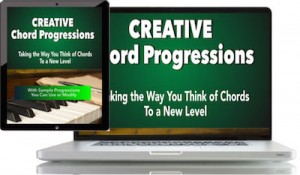We all get something different out of music. For some, music is beautiful sound that gets played quietly on the home stereo, never turned up: musical wallpaper. For others, music defines who they are and takes a central role. It gets turned up loud and listened to.
And more than just listening to music because we like the sounds, we often go looking for meaning in music. We pay attention to words, and enjoy when we think we hear something musical that enhances the meaning of the lyric.
 Do you get stuck trying to come up with chords that work with your melody? “How to Harmonize a Melody” is the eBook that shows you, step by step, how to do exactly that. Buy it separately, or as part of “The Essential Secrets of Songwriting” 10-eBook Bundle.
Do you get stuck trying to come up with chords that work with your melody? “How to Harmonize a Melody” is the eBook that shows you, step by step, how to do exactly that. Buy it separately, or as part of “The Essential Secrets of Songwriting” 10-eBook Bundle.
Music wasn’t always that way. With early blues and rock & roll, about the only thing that defined if a song was happy or sad was tempo. Whether the content was happy (“Teddy Bear“), or sad (“Am I Losing You?“), it would be hard to tell what the mood of a song was if you didn’t hear the words.
Starting in the 60s, there was a gradual move toward creating music that had an emotional side. Even forgetting about lyrics, the music started to sound happy (“Hot Fun in the Summertime“), sad (“Without You“), melancholy (“All By Myself“), and all emotions in between.
It all begs the question: Does music need to mean anything? Are we so connected to lyrics now that the meaning of the words is all we need to create meaning in music?
I tend to believe that music on its own needs to somehow impart meaning to an audience. In other words, if you’ve written a sad song, the music needs to exhibit that emotion, even without the lyric.
I’m well aware that in this sense, musical meaning is largely a cultural response. Music that sounds happy or sad tends to sound that way because of our past experience with music, and I suspect that every culture is different.
But there’s nothing wrong with that. Manipulating music to express emotions is what today’s music is all about.
You may wonder if your music is properly supporting the emotion of your lyric. If the two are at odds, you may be missing out on an opportunity to make a strong, emotional connection to your fans.
So here are some ideas for making sure that your music is supporting the emotion of your lyric:
- Play your latest song as an instrumental. Try to determine as a first step if you’re picking up an emotion at all from the song.
- Consider chord substitutions. It’s not exactly true to say that sad songs are minor and happy songs are major; that’s a bit of a stereotype. But it is often true that melancholy/sad songs will use minor chords in place of major ones, regardless of key. For example, note the difference between these two simple progressions: 1) C G F G C; and 2) C G Dm G C. The Dm can pull a mood toward something less jovial than F. Other substitutions that move music toward melancholy: replace I-chords with vi-chords, and try a iii-chord in place of a V-chord. (And vice versa, of course, if you’re looking to cheer up the sound of your music.)
- Consider the direction of bass lines and melody lines. Generally speaking, upward-moving lines cause us to feel happy or hopeful. If you’re a fan of “The West Wing“, you’ll notice that the theme music features a bass line that moves steadily upward in the middle section, and it gives the music an optimistic feel. It’s often true of melodies as well.
Most of the reactions we have to music are purely subjective, but I say long live subjectivity when it comes to music. Not everyone will have the same emotional reaction to your musical choices, and you shouldn’t expect that.
But if you’ve done nothing to draw out some sort of emotional reaction from your audience to your music, it may be all coming across as a bit antiseptic. It may be time to separate the music from the lyric, and work to create musical meaning that gives your lyric that much more power.
Written by Gary Ewer. Follow on Twitter.
 “The Essential Secrets of Songwriting” eBook Bundle has been used by thousands of songwriters to polish their technique and take their music to a new and exciting level of excellence. For a limited time, the 10-eBook Bundle includes an 11th FREE ebook: “Creative Chord Progressions”
“The Essential Secrets of Songwriting” eBook Bundle has been used by thousands of songwriters to polish their technique and take their music to a new and exciting level of excellence. For a limited time, the 10-eBook Bundle includes an 11th FREE ebook: “Creative Chord Progressions”
$37 USD (Immediate download)











Pingback: Dépêche Mode – Get The Balance Right (1984) | mostly music
I write song lyrics, i’m never sure how to add music to those lyrics. I like how in songs by Muse, the beat’s fast first, then gets really slow, then goes back to that fast beat; I wanted to do that, but i’m never sure how to add music